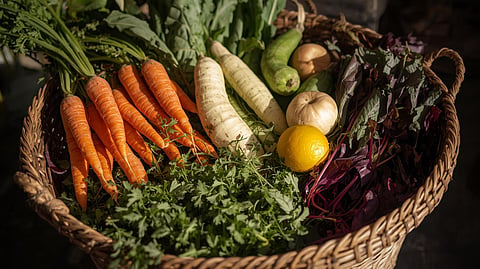

The Carbon Cost of Cuisine (Food Miles)
Every time you buy produce that has been flown or trucked across the country (or the globe), you are adding to your meal’s carbon footprint. Non-seasonal food often requires extensive energy for refrigeration, artificial ripening, and long-distance transport — what is commonly known as 'food miles'. The most sustainable food is the food that is naturally available in your region, right now.
The Seasonal & Local Checklist
Diwali generally falls at the cusp of the winter harvest in India. This is the time to embrace hardy, local, and nutritious crops:
1. Grains: Look for the new harvest of grains. If you live in an area where rice is grown, buy the fresh stock. Otherwise, switch to drought-resistant, local millets (bajra, jowar) for your snacks and bread—they require far less water to grow and are hyper-local.
2. Vegetables: Embrace the coming of winter: carrots (gajar), beetroots, and various winter greens. These are perfect for making traditional, hearty side dishes and desserts (gajar ka halwa).
3. Spices & Oils: Source your spices from local mandis. Choose locally-pressed, unrefined mustard, groundnut, or sesame oil for cooking, reducing the consumption of heavily processed, non-local oils.
Supporting the Local Economy
Shopping at your nearest sabzi mandi or from farmer co-ops is an act of sustainable economics. You eliminate the complex, resource-intensive corporate supply chain and put money directly into the hands of the local Indian farmers. This not only ensures better prices for them but also guarantees you get the freshest, most nutrient-dense ingredients.
By creating a menu based on what the earth is offering now, you celebrate a truly authentic, low-carbon Diwali feast that honors both tradition and the planet.
